Fulham
Hospital
St Dunstan's Road, W6
Medical
dates:
Medical
character:
Acute
The Fulham workhouse opened on
the east side of Fulham Palace Road in 1849 with accommodation for up
to 450 inmates.
The Fulham Union Infirmary was erected in St Dunstan's Road to the north of the workhouse to provide minimal medical care to the workhouse sick. It opened in 1884 with two doctors and 31 nurses to look after 486 patients, a large proportion (34%) of whom were chronically ill or senile. Leg ulcers were the predominant reason for admission for surgery, whereas medical admissions were for lung disease (bronchitis, pneumonia and TB). Medical cases outnumbered surgical ones threefold.
Shortly after opening a telephone was installed in the Infirmary, mainly so that MAB could be contacted to remove infective patients.
By 1890 there were 35 nurses on the staff.
In 1905 an Operating Room was installed. In the same year a Nurses' Home - Brandenburg House - was built opposite the Infirmary on the west side of Fulham Palace Road (later a subway would link the Nurses' Home to the Infirmary).
By 1910 surgical treatments had become increasingly important, but the Infirmary lacked an Out-Patients Department for follow-up care; patients were seen in any available room.
At the beginning of WW1 wounded soldiers from the Ypres battleground were brought to Fulham. In 1915 the War Office took over the workhouse and Infirmary - as it did with several other Poor Law institutions - and they became the Fulham Military Hospital. The Hospital had almost 1,000 beds. The large workhouse dining hall was utilised for meals by convalescent soldiers, and weekly entertainments were also held there. In December 1915 the Queen visited.
Syon House in Brentford, home of the Duke of Northumberland, was allotted to Fulham Military Hospital as an auxiliary hospital for officers.
During the war the Army improved and upgraded conditions at the Hospital. By 1917 there were 1130 beds, including 318 for German prisoners. Some 50 beds were for patients undergoing Carrel-Dakin treatment for their wounds and 34 for those with cerebrospinal fever (meningitis). The X-ray Department was also upgraded - 50 skiagrams (X-rays) had been obtained in 1914 but 5,530 in nine months alone in 1916. In 1918 Fulham Palace was vacated by the Bishop of London and became a convalescent home for 100 soldiers with shell shock.
The war ended just as the Spanish flu epidemic began to affect staff and patients, and a great number of them died in November 1918.
In 1919 the military occupation came to an end and the Fulham Military Hospital was renamed the Fulham Infirmary. Not all wards could be reopened immediately because of a shortage of staff. At this time there were 354 beds.
By 1922 bed numbers had increased to 550. More specailists - a neurologist and an orthopaedic surgeon - were appointed to the staff. In 1925 it was decided to change the name again, as the word 'infirmary' carried the stigma of the workhouse and paupery. The name 'Fulham Hospital' was narrowed rejected and 'St Christopher's Hospital' chosen (St Christopher was the patron saint of the 'Tenders of the Sick at Fulham', i.e. the nursing staff). However, one month later the decision was reversed and the name became 'Fulham Hospital' (not to be confused with the Fulham Hospital in Seagrave Road, which had become the Western Fever Hospital in 1885). The Fulham workhouse became the Fulham Institution, a hospital caring for the chronic sick and aged. Improvements to accommodation reduced the numbers of places in the former workhouse from 637 to 475, whereas the Fulham Hospital, dealing with acute cases, increased its bed numbers from 546 to 564.
In 1929 a new Nurses' Home was built on the south side of the workhouse site.
In 1930 the LCC took over administration of the Hospital. By 1934 the Hospital, on its site of just under 2 acres, had 555 beds, while the Institution, on its 6 acre site, had 474 inmates. It was decided to merge the two, and the Hospital for acute patients became Fulham Hospital 1 and the Institution for the chronic sick became Fulham Hospital 2. Infirm inmates were moved to other public institutions, leaving a total of 144 beds for the chronic sick. By the late 1930s the Fulham Hospitals had 711 beds.
In 1937 a new Maternity Home was opened in Parsons Green by Fulham Borough Council and the maternity ward at Fulham Hospital closed, although maternity cases were sometimes admitted.
At the beginning of WW2 the Hospital received wounded soldiers from Dunkirk. In 1940 bomb damage occurred on several occasions. In the first incident an empty ward block was destroyed and the chapel damaged. Two weeks after this a bomb hit the laundry and boiler house, leaving the Hospital without hot water. All patients had to be transferred but the damage was repaired within three weeks. Ten days after this, another bomb destroyed the gas supply; this was repaired after two weeks. The final bomb to fall on the Hospital destroyed its entrance and main gates. Amazingly, no-one was killed in any of the incidents and no further bomb damage occurred after 1940, but Fulham Hospital 2 was closed.
Following the war, the talk of rebuilding the Hospital began in earnest in 1946. In 1948 it joined the NHS, with 394 beds. A converted ward served as an Out-Patients Department.
In 1951 the management committee decreed that, in order to save money, the old workhouse dining room would be used by all staff and the separate dining rooms for doctors, sisters and nurses would be closed. Most of the staff refused to cooperate with this scheme and the status quo was quickly restored.
In 1957 the workhouse building was demolished. Plans for rebuilding had stalled but in 1959 came the unexpected and unwelcome news that Charing Cross Hospital would be coming to Fulham. Despite local protest, Fulham Hospital became part of the Charing Cross Group.
Building works for the new hospital began at the centre of the site, where the former workhouse and Board of Guardians offices had been.
The Fulham Hospital was demolished piece by piece and finally closed in 1973, never having achieved its ambition to build a proper Out-Patients Department. The new Charing Cross Hospital (Fulham) was opened by Queen Elizabeth II in the same year.
Present status (May 2008)
Fulham Hospital has been completely demolished, although the weathervane is preserved. Charing Cross Hospital now occupies the site.
The Fulham Union Infirmary was erected in St Dunstan's Road to the north of the workhouse to provide minimal medical care to the workhouse sick. It opened in 1884 with two doctors and 31 nurses to look after 486 patients, a large proportion (34%) of whom were chronically ill or senile. Leg ulcers were the predominant reason for admission for surgery, whereas medical admissions were for lung disease (bronchitis, pneumonia and TB). Medical cases outnumbered surgical ones threefold.
Shortly after opening a telephone was installed in the Infirmary, mainly so that MAB could be contacted to remove infective patients.
By 1890 there were 35 nurses on the staff.
In 1905 an Operating Room was installed. In the same year a Nurses' Home - Brandenburg House - was built opposite the Infirmary on the west side of Fulham Palace Road (later a subway would link the Nurses' Home to the Infirmary).
By 1910 surgical treatments had become increasingly important, but the Infirmary lacked an Out-Patients Department for follow-up care; patients were seen in any available room.
At the beginning of WW1 wounded soldiers from the Ypres battleground were brought to Fulham. In 1915 the War Office took over the workhouse and Infirmary - as it did with several other Poor Law institutions - and they became the Fulham Military Hospital. The Hospital had almost 1,000 beds. The large workhouse dining hall was utilised for meals by convalescent soldiers, and weekly entertainments were also held there. In December 1915 the Queen visited.
Syon House in Brentford, home of the Duke of Northumberland, was allotted to Fulham Military Hospital as an auxiliary hospital for officers.
During the war the Army improved and upgraded conditions at the Hospital. By 1917 there were 1130 beds, including 318 for German prisoners. Some 50 beds were for patients undergoing Carrel-Dakin treatment for their wounds and 34 for those with cerebrospinal fever (meningitis). The X-ray Department was also upgraded - 50 skiagrams (X-rays) had been obtained in 1914 but 5,530 in nine months alone in 1916. In 1918 Fulham Palace was vacated by the Bishop of London and became a convalescent home for 100 soldiers with shell shock.
The war ended just as the Spanish flu epidemic began to affect staff and patients, and a great number of them died in November 1918.
In 1919 the military occupation came to an end and the Fulham Military Hospital was renamed the Fulham Infirmary. Not all wards could be reopened immediately because of a shortage of staff. At this time there were 354 beds.
By 1922 bed numbers had increased to 550. More specailists - a neurologist and an orthopaedic surgeon - were appointed to the staff. In 1925 it was decided to change the name again, as the word 'infirmary' carried the stigma of the workhouse and paupery. The name 'Fulham Hospital' was narrowed rejected and 'St Christopher's Hospital' chosen (St Christopher was the patron saint of the 'Tenders of the Sick at Fulham', i.e. the nursing staff). However, one month later the decision was reversed and the name became 'Fulham Hospital' (not to be confused with the Fulham Hospital in Seagrave Road, which had become the Western Fever Hospital in 1885). The Fulham workhouse became the Fulham Institution, a hospital caring for the chronic sick and aged. Improvements to accommodation reduced the numbers of places in the former workhouse from 637 to 475, whereas the Fulham Hospital, dealing with acute cases, increased its bed numbers from 546 to 564.
In 1929 a new Nurses' Home was built on the south side of the workhouse site.
In 1930 the LCC took over administration of the Hospital. By 1934 the Hospital, on its site of just under 2 acres, had 555 beds, while the Institution, on its 6 acre site, had 474 inmates. It was decided to merge the two, and the Hospital for acute patients became Fulham Hospital 1 and the Institution for the chronic sick became Fulham Hospital 2. Infirm inmates were moved to other public institutions, leaving a total of 144 beds for the chronic sick. By the late 1930s the Fulham Hospitals had 711 beds.
In 1937 a new Maternity Home was opened in Parsons Green by Fulham Borough Council and the maternity ward at Fulham Hospital closed, although maternity cases were sometimes admitted.
At the beginning of WW2 the Hospital received wounded soldiers from Dunkirk. In 1940 bomb damage occurred on several occasions. In the first incident an empty ward block was destroyed and the chapel damaged. Two weeks after this a bomb hit the laundry and boiler house, leaving the Hospital without hot water. All patients had to be transferred but the damage was repaired within three weeks. Ten days after this, another bomb destroyed the gas supply; this was repaired after two weeks. The final bomb to fall on the Hospital destroyed its entrance and main gates. Amazingly, no-one was killed in any of the incidents and no further bomb damage occurred after 1940, but Fulham Hospital 2 was closed.
Following the war, the talk of rebuilding the Hospital began in earnest in 1946. In 1948 it joined the NHS, with 394 beds. A converted ward served as an Out-Patients Department.
In 1951 the management committee decreed that, in order to save money, the old workhouse dining room would be used by all staff and the separate dining rooms for doctors, sisters and nurses would be closed. Most of the staff refused to cooperate with this scheme and the status quo was quickly restored.
In 1957 the workhouse building was demolished. Plans for rebuilding had stalled but in 1959 came the unexpected and unwelcome news that Charing Cross Hospital would be coming to Fulham. Despite local protest, Fulham Hospital became part of the Charing Cross Group.
Building works for the new hospital began at the centre of the site, where the former workhouse and Board of Guardians offices had been.
The Fulham Hospital was demolished piece by piece and finally closed in 1973, never having achieved its ambition to build a proper Out-Patients Department. The new Charing Cross Hospital (Fulham) was opened by Queen Elizabeth II in the same year.
Present status (May 2008)
Fulham Hospital has been completely demolished, although the weathervane is preserved. Charing Cross Hospital now occupies the site.
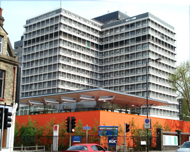
Charing Cross Hospital from Fulham Palace Road. Officially named Charing Cross Hospital (Fulham), the '(Fulham)' part of the title was dropped quite soon after opening
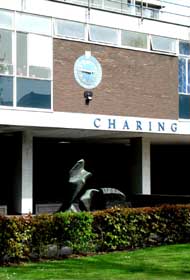
Public art outside the main entrance
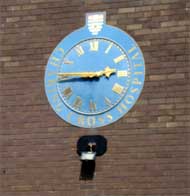

The main entrance
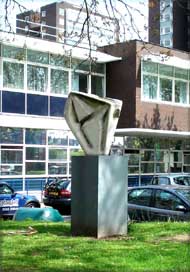
More public art on the Hospital forecourt
The Charing Cross Hospital clock above the main entrance
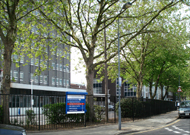
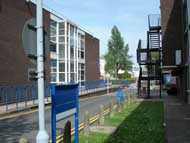

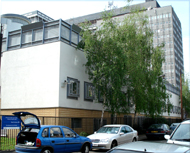
Various buildings at the back of the Hospital for mental health departments
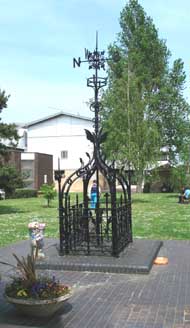
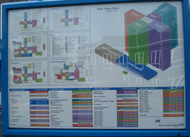
The Hospital site plan lists all the departments that would never have been found in a Victorian hospital - X-ray, MRI and CT, ultrasound, nuclear medicine, radiotherapy and vascular intervention.
(Author unstated) 1915 The Fulham Military Hospital, Hammersmith. British Journal of Nursing, 25th December, 523.
(Author unstated) 1917 List of the various hospitals treating military cases in the United Kingdom. London, H.M.S.O.
Wyman AL 1988 Medicine in the parish of Fulham from the Fourteenth Century: Fulham Hospital 1884-1959. London, Fulham & Hammersmith HS
http://hansard.millbanksystems.com
http://rcnarchive.rcn.org.uk
www.workhouses.org.uk
Return to home page